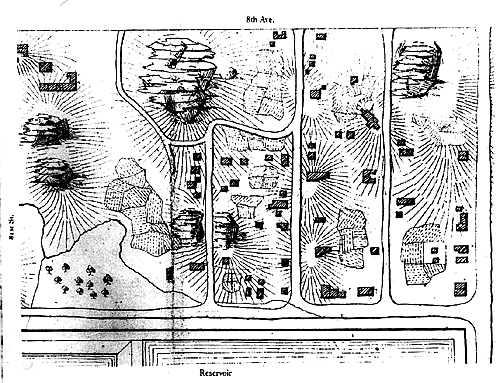
“Map showing the former location of Seneca Village” CC/BY Egbert Viele. Caption: Seneca Village spanned from West 82nd Street to West 89th Street, a distance of 0.4 miles, or 2112 feet. Much of this land makes up part of what is now Central Park in New York City.
Seneca Village – The dark history of Central Park
In New York City, Central Park is one of the few spots where people can enjoy nature. However, this benefit came at a steep price. Central Park is built over the bones of Seneca Village, a once prosperous Black community that provided a safe haven from the oppressive nature of New York.
Seneca Village began development in 1825 when John and Elizebeth Whitehead sold several lots of their land to two Black men, Andrew Williams and Epiphany Davis, and the AME Zion Church. Until 1835, the Whiteheads sold about half of their land, around 100 parcels, to other African Americans. By the 1850s, Seneca Village consisted of 50 homes, three churches, burial grounds, and a school.
During the 1800s in the state of New York, having voting rights required being a landowner of a property worth more than $250 and being a state resident for at least three years. Of the Black residents in the state, only 100 were eligible to vote, and 10 of them resided in Seneca Village.
The village’s location was likely one of the contributing factors to its prosperity. Surrounding it was the Hudson River, which provided a source of fish, and Tanner’s Spring, which provided fresh water. It is suggested that the village supported gardens as well as the raising of livestock. Seneca Village was also fairly isolated from other communities, which allowed the residents to avoid discrimination and prevent overcrowding that developed as a result of urbanization.
In the 1850s, New York City began plans to counter the unhealthy effects of the urban atmosphere, which included using 775 acres of land in Manhattan as Central Park. Spanning 59th to 106th streets and between Fifth and Eighth Avenues, the plans for Central Park enveloped the land on which Seneca Village stood. Using the law of eminent domain, the city could take private land as long as the owners were compensated, displacing 200 inhabitants.
While Central Park provides an essential purpose to the residents of New York City, its history should be known. Central Park is a reminder of the ways that, even in the modern era, the oppression of Black people continues to benefit many Americans.